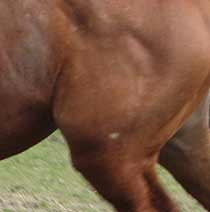Sticky or Locking Stifle in a Horse - Cause and Treatment

'Sticky Stifle' is a result of a slight problem
with the locking mechanism which fixes the stifle joint and allows
the horse to stand sleeping - as a result, the rest of the horse's
hind leg is affected.
Sometimes this locking mechanism in the stifle gets "stuck"
and the horse or pony drags
his hind leg and toe.
This common condition is also called upward fixation
of the patella.
A horse affected by a locked stifle joint can
become quite distressed and tends to hold the leg out straight.
"Popping" sounds can sometimes be heard coming from
the stifle joint.
An 'upward fixating patella' can usually be
diagnosed with ultrasound or X rays. If necessary , a bone scan
or MRI scan can confirm this diagnosis.
What causes a Sticky Stifle in a horse?
4 bones make up the stifle joint in the horse - the patella,
femur, tibia and fibula.
The patella (knee cap) has 3 ligaments extending from its base
to the to the tibia (or shin bone).
On the end of the femur (thigh bone) there is a notch
and it is the interaction between the ligaments and this notch
that causes the upwards fixation or stuck stifle.
There is a groove between the inside and centre ligaments
of the patella, and this groove hooks over the
notch of bone on the femur
The problem in some young horses is that the
notch has too much of a lip on the front and the patella ligaments
get stuck.
With age and growth the notch is re-modelled by the horse's body
and it is reshaped into the most effective form.
Unfortunately, we come along and upset nature's balance by getting
the horse fitter than the skeleton is ready for and toning up
the quadriceps muscle, which means that the patella is held fractionally
higher. Then if the horse is rested the quadriceps get flabbier
and consequently the patella gets stuck in the notch.
A locked stifle is most often seen in
younger horses, especially if they have been worked for
a while and then turned away.
It is also seen in horses who are growing abnormally
fast and disproportionately as the bones and ligaments
become mismatched.
|